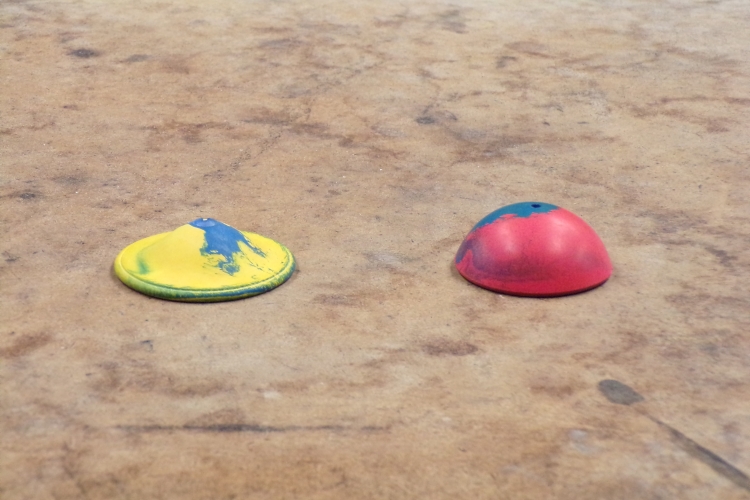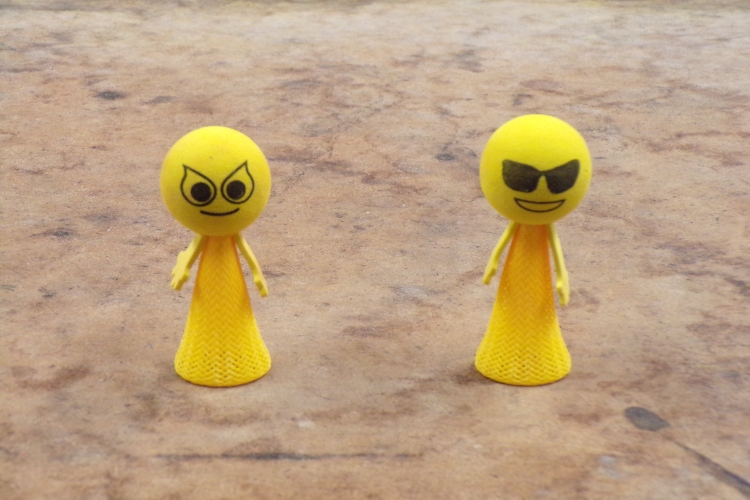
Turn one of the handball halves inside out, set it concave side down on the table, and release it. After a minute or two (if it is the yellow/blue half; almost immediately if it is the red/blue half), it will snap back to its original shape. When this happens, the handball half jumps high into the air. In addition, or alternatively, you can use one of the “smile poppers” shown below.
When you press down the head of one of these toys and then release it, the popper jumps high in the air.
This demonstration is similar to demonstration 20.27 -- Launch sleeve with compressed spring, in which you press down on a brass collar to compress a spring, and when you release it, the collar flies upward. The springs in that demonstration essentially obey Hooke’s law, that is, the force exerted by the spring changes linearly with the distance through which you compress it (F = -kx). As either a handball half or one of the poppers returns from its compressed state to its original state, however, the force it exerts on the table (and thus has exerted on itself in the opposite direction) is probably far from linearly related to its change in height. Still, the tension in the rubber of the handball or the plastic of the popper in its distorted state corresponds to a certain amount of potential energy, which is released as the handball half or popper returns to its original shape. As this happens, the handball half or popper does a corresponding amount of work, launching itself into the air to a height above the table that corresponds to the gravitational potential energy equal to the amount of potential energy that had been stored in the compressed handball half or popper. In this respect, its behavior is similar to that of the compressed spring launching the sleeve.
Each handball half has a mass of 20 g. The (vertical) distance traveled by its outer edge as it snaps to its original shape is about 2.2 cm. The yellow/blue handball half jumps to a height of about 2.0 m, and the red/blue handball half rises to about 2.2 m. (These are based on averages of five round trip times each, divided in half to obtain the rise or fall time.) The potential energies to which these correspond (= mgh) are, respectively, (0.020 kg)(9.8 m/s2)(2.0 m) = 0.39 J and (0.020 kg)(9.8 m/s2)(2.2 m) = 0.43 J. These correspond to the kinetic energy each handball half had just as it left the table surface, from which we can calculate the initial speed of each handball half at launch. Since K = (1/2)mv2, v = √[(2K)/m]. For the yellow/blue handball half, the initial speed is √([2(0.39 J )/0.020 kg] = 6.2 m/s, and for the red/blue handball half it is √([2(0.43 J )/0.020 kg] = 6.6 m/s. While we do not know how much, if any, energy was lost in the handball half returning to its original shape, we know from the measured (gravitational) potential energy, the minimum energy that must have been stored in it before it flipped. Also, we do not know how the force changes as the handball half returns to its original shape, but we have some idea of the distance over which it acts, and we can calculate the average force that, acting over that distance, should perform the quantity of work that would launch the handball half to the measured height. If we take 2.2 cm as the distance over which the force acts, then for the yellow/blue half, the force is 0.39 J/0.022 m = 18 N, and for the red/blue half it is 0.43 J/0.022 m = 20 N.
The popper on the left (smiley) has a mass of 4.6 g, compresses by about 3.6 cm and jumps about 1.3 m, and the one on the right (shades) has a mass of 4.7 g, compresses by about 3.9 cm and jumps about 1.8 m. (Again, the jump height is from an average of five round trip times, divided by two to obtain the rise or fall time.) For these toys, drag probably has some effect, but we will ignore it. The potential energies at maximum height are, for smiley, (0.0046 kg)(9.8 m/s2)(1.3 m) = 59 mJ, and for shades, (0.0047 kg)(9.8 m/s2)(1.8 m) = 83 mJ. For smiley, the initial speed is √([2(0.059 J )/0.0046 kg] = 5.1 m/s, and for shades it is √([2(0.083 J )/0.0047 kg] = 5.9 m/s. Taking the compression distance as the distance over which the force acts, as we did for the handball halves, we calculate an average force for smiley of 0.059 J/0.036 m = 1.6 N, and for shades of 0.083 J/0.039 m = 2.1 N.
Below is a table with all of the values measured and calculated above. Δx is the distance over which the handball or popper moves as it returns to its original shape. Average force is the force, acting over Δx, that would launch the object to the measured jump height.
Yellow/blue handball half Red/blue handball half Smiley popper Popper with shades
